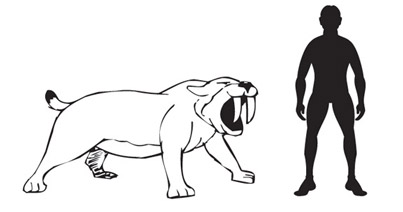Estimating the Size of Smilodon (Sabre-Tooth Cats)
Estimating the Size of Sabre-Tooth Cats
With the Roland Emmerich directed film 10,000 B.C. proving popular with UK cinema audiences over the Easter holidays, staff at Everything Dinosaur have seen a resurgence in queries and questions related to prehistoric mammals.
Woolly mammoths and Sabre-tooth cats (Smilodon spp.) tend to be the most popular of all the now extinct mega fauna of the Cenozoic, the fact that these animals play a prominent role in this new film will no doubt add to their popularity. Certainly both animals are very enigmatic, although the size of these prehistoric beasts tends to be taken a little bit out of proportion by the Hollywood special effects teams.
Take the fearsome Sabre-Tooth cat for example, the best known and most researched species would be S. fatalis and the two sub-species from North America. The superbly preserved remains removed from the La Brea tar pits have provided a huge amount of fossil evidence. This fierce predator was not the largest of the Smilodon species. Smilodon populator of South America, is believed to have been a little larger, perhaps exceeding 1.2 metres at the shoulder.
The impression re-produced below gives a rough idea of the scale of the largest Smilodon species when compared against a human (not that we would recommend anyone attempting to get too close to one of these creatures)!
A Sketch Illustrating the Size of the large Smilodon (S. populator) compared to a Person

Picture credit: Everything Dinosaur
Smilodon
The largest Smilodon would have been about the size of a male African lion (Panthero leo), but up to 300 kilogrammes in weight, making them much more heavy set than the largest of the big cats around today.
When it comes to the “top dogs” in the cat family the Panthero genus (lions) may have the last laugh, several extinct sub-species of Panthero leo may have been even larger than the biggest Smilodon. It seems that those “big cats” such as S. populator, belonging to the sub-family of Machairodontinae, had some pretty strong competition from other members of the Felidae. Take for example the American lion (Panthero leo atrox), a contemporary of Smilodon fatalis, this fearsome beast is estimated to have been about the same height and weight of the largest of the Smilodon genus but less compact, perhaps reaching lengths in excess of 2.5 metres.
American Lion
Although the American lion is known from the La Brea fossil deposits, relatively few remains have been found when compared to other carnivores such as the Dire wolves (C. dirus) and Smilodon fatalis. Perhaps the lack of fossils indicates that there were relatively fewer lions within the ecosystems that the fossil record represents, or maybe the American lion had a different hunting strategy and preferred habitat that took it away from La Brea. Perhaps the American lion was just a little too smart to get caught in the tar pits.
Ironically the largest carnivore from the La Brea deposits is not a member of the Felidae at all. The Short-faced bear (Arctodus simus), was the largest carnivorous animal around the area of La Brea towards the end of the Pleistocene. A massive animal 1.5 metres high at the shoulder, capable of raising itself to a height of 3 metres or more and weighing perhaps as much as 800 kilogrammes, if a member of the Felidae stumbled across one of these bears, it would be better off getting out of its way. The Short-faced bear is reputed to have been the largest bear to have ever existed. Compared to modern brown bears its limbs were much longer and it had a short, broad muzzle (hence its name). The jaws were extremely powerful and this animal would have had an awesome bite.
Little is known about the behaviour and habits of the Short-faced bear. Chemical analysis of fossilised bones indicate a predominately carnivorous diet, but whether this bear was an active hunter of a scavenger is unknown. It was certainly capable of chasing off both Smilodon fatalis and the American Lion in order to take over a recent kill.
Everything Dinosaur stocks an extensive range of prehistoric mammal figures: Prehistoric Mammal Figures.

